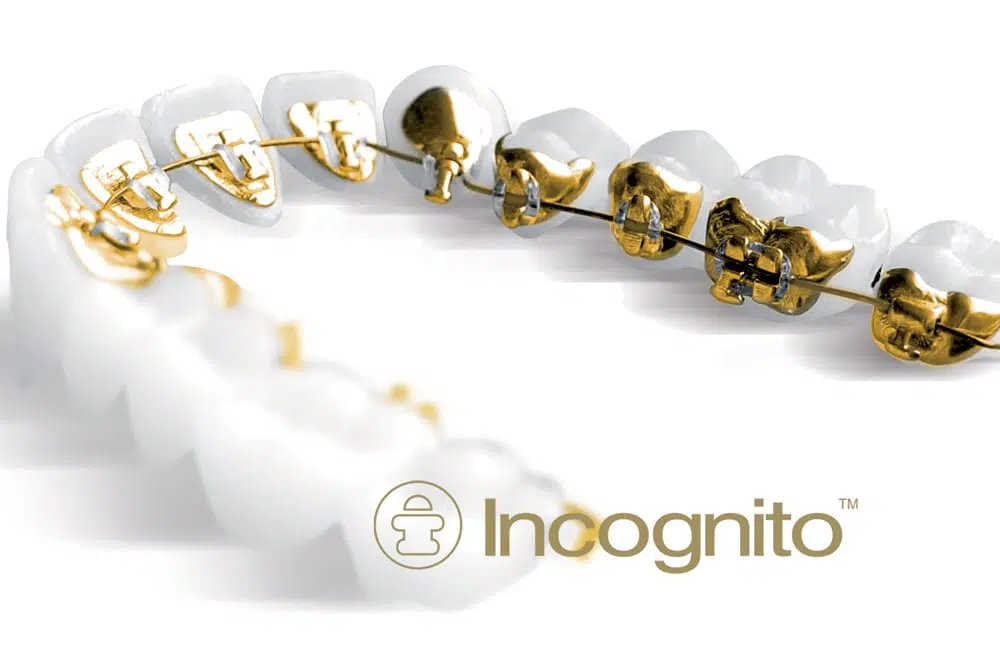Accepting New Patients! San Francisco: 415-874-1677 Sonoma: 707-935-6878
Lingual Braces in San Fracisco
Learn more about our Lingual Braces services in San Francisco! If you have any
questions, don’t hesitate to reach out to one of our team members.
If you’re thinking about getting braces, you’re probably already looking forward to your new smile. But you don’t need to wait until the braces come off to smile with confidence! Incognito Hidden Braces work behind the scenes – literally – so no one can see you’re wearing braces. The braces are hidden behind your teeth and practically invisible when you smile. And they’re 100% customized for you, so you can be confident in the results.
With over 100,000 patients treated worldwide, there’s a good chance you’ve seen someone wearing them and you didn’t even know it!
Life with Lingual Braces
Since these Incognito invisible braces in San Francisco rest near your tongue, patients typically experience an adjustment period of roughly 2 weeks. At that point, most people barely notice the braces and begin to speak the same as they did prior to getting braces.
As with all orthodontic treatments, hygiene is extremely important. An electric toothbrush provides the most effective method for cleaning, and flossing is just as important as ever.
Water-based toothpicks do a good job of keeping the mouth feeling fresh throughout your treatment, particularly around brackets and on the tongue. Mouthwash is also fine to use on lingual braces.

Common Questions About Clear Braces in San Francisco
Incognito lingual braces are completely hidden behind your teeth. You don’t have to worry about taking them out to eat, and you don’t have to track the number of hours you must wear them each day.
Brackets and wires are engineered to deliver precise, targeted results through advanced digital technology. Everything is customized just for you for the best possible comfort and treatment success.
With over 100,000 patients treated worldwide, there’s a good chance you’ve seen someone wearing them and you didn’t even know it!
We strive to...
-
Create customized treatment plans that fit your budget and your lifestyle
-
Educate ourselves by taking continuing education credits
-
Invest in efficient, modern, and eco-friendly LEED principles for our practice
-
Promote a welcoming office environment for both patients and staff
Insurance & Billing
Each insurance carrier offers a variety of benefit plans with different features. As a
courtesy to you, we will directly bill your insurance company. Call us today to learn more.








Why Choose Our Practice
Complimentary Consultations
Our friendly staff is here to help you look and feel better through modern orthodontics. Schedule an appointment to receive a consultation with the top San Francisco orthodontist.
Platinum Provider of Invisalign®
Dr. Riaño is honored to be a Top 1% Diamond Invisalign® Provider. This remarkable appliance straightens your teeth using a series of virtually invisible aligners.
Flexible Insurance + Interest Free Financing
We are in-network with most major PPO plans and we offer interest-free in-house payment plans!
Your Lifestyle Dictates Your Treatment Plan
We are proud to offer treatments based around your lifestyle. Whether you are focused on finances, comfort, aesthetics or efficiency - we've got a treatment plan for you.
Voted Best Orthodontist in San Francisco
We are so thankful for being voted Best Orthodontist in San Francisco for 2021 by SF Weekly. We encourage you to read some of our 150+ positive Google reviews.
Centrally Located For Your Convenience
We are centrally located within walking distance of BART, the Civic Center, and schools. Contact us today to schedule a complimentary consultation.
500+ Satisfied Patients
We're so thankful to have such amazing patients that have taken the time to share their experiences on Google, Facebook, RateMDs, and other online sources.
Contact Camilo Riaño: Your San Francisco Orthodontist
77 Van Ness Ave #303
San Francisco, CA 94102
Office Hours
| Day | Hours |
|---|---|
| Monday | 8:15 AM - 5:00 PM |
| Tuesday | 8:15 AM - 5:00 PM |
| Wednesday | 9:15 AM - 6:00 PM |
| Thursday | 8:15 AM - 5:00 PM |
| Friday | 7:45 AM - 3:30 PM |
| Saturday | By Appointment Only |
| Sunday | Closed |

